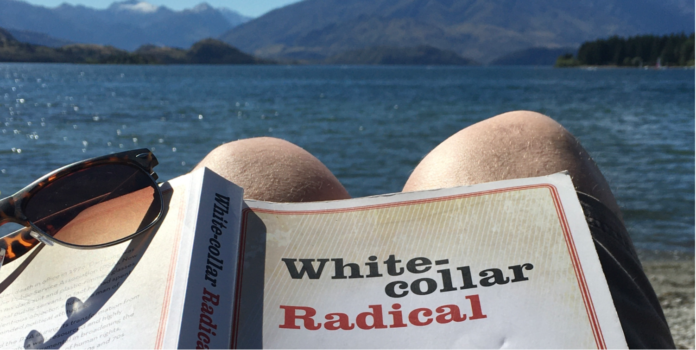It was January, 1997 when I first joined the Public Service Association.
Starting as a new grad nurse at Auckland DHB with nearly a decade of student activism under my belt, as well as a Nursing degree, there was never a doubt that I would join the union. The following year I would become a PSA delegate, and before long I was representing Health Sector members at the PSA Congress.
But as a budding student of labour history, I was aware at the outset of the widespread perception that the union I was joining was on the conservative – even “Right wing” – end of the labour movement.
The 1990s had delivered an unprecedented shock to workers’ organisations in New Zealand. Under the Employment Contracts Act (ECA) passed by the National Government in 1991, employers set out to smash the union movement. They almost succeeded. In eight short years, from 1989 to 1997, the proportion of wage and salary earners in unions collapsed from 44.9 percent to 19.2 percent. In the health sector union membership held up slightly better, but the national workforce was divided up into small groups, hospital by hospital, and prohibited by law from uniting to take action together.
Unions responded to the crisis in very different ways. At one end of the spectrum, the PSA led a push by some to embrace “partnership” with employers (often the very same employers who were cutting jobs, pay and conditions for union members). They adopted a “service model” of unionism, where the paid officials focused on providing advice and individual representation, rather than organising delegates and members to act collectively in the workplace to tackle shared issues. And there was a common view – later confirmed in the official history of the PSA released to mark its centenary – that my union was largely responsible for pulling the plug on a general strike to resist the ECA in May, 1991.
When the tide eventually turned in 1999, with the election of the Labour-Alliance Government under Helen Clark and the repeal of the ECA, I raised with my PSA organiser the idea of uniting across different hospitals to re-create a Multi-Employer Collective Agreement (MECA) for Mental Health Nurses. But by this stage, the conservatism ran deep. I was told, it’ll never happen. The wide variety of terms and conditions in the different hospital-based employment agreements meant it would be impossible to harmonise them again in a single MECA.
So when I moved to Wellington in 2002 and had the option of joining the New Zealand Nurses Organisation – which at that time was pursuing a strategy to re-create a national Nursing MECA covering all DHBs – I leapt at the chance. I couldn’t really understand my older Nursing colleagues who remained luke warm about NZNO, continuing to insist that the PSA was “more of a real union”.
After reading White-collar Radical – Dan Long and the rise of white-collar unions, I finally understand.
White-collar Radical is really two books in one. First of all, it’s a biography of Dan Long, the man who led the union as its General Secretary from 1960 until his untimely death in 1976. This part, which fully occupies the first quarter of the book and intermittent sections after that, was for me the less interesting.
It’s no fault of the author. The subject of the biography is simply someone described at various points as “circumspect”, “measured”, “not an effective public speaker”, “not fast, or funny”, “restrained, and even ponderous” – in short, someone whose personal life just isn’t terribly exciting to read about. On top of that, documentary evidence about Dan Long before his rise up the PSA is apparently so scarce that the book resorts to quoting some material that’s fairly marginal in its relevance.
But in addition to this biography, the book is also a history of the PSA, focusing on the period from the 1940s to the 1970s. And this, for me, was absolutely fascinating.
One of the most inspiring episodes in White-collar Radical is the account of New Zealand’s first ever Nurses’ strike (pp.182-186). This isn’t the strike usually credited as the first – the 24-hour, nationwide stoppage by NZNO members in 1989. It was eighteen years earlier in 1971, that PSA Mental Health Nurses at Oakley Hospital in Auckland walked off the job for two weeks.
The immediate trigger for the action was a threat by employers to remove the “mental health lead” – the higher pay rate for Mental Health Nurses above that of General Nurses. But “significantly, when the PSA leadership at Oakley called for a strike the demands sought not only a successful outcome to the salary claim but also a Commission of Inquiry into conditions at Oakley… Those who felt that at all times ‘the patient must come first’ could feel that the strike was doing this because of the demand for an inquiry… The Oakley strike was made possible, not because staff disregarded an ethical relationship with the patients, but for reasons which were precisely the opposite.”
The strike quickly spread, with Mental Health Nurses at Sunnyside and Templeton in Christchurch taking industrial action, followed by staff at Kingseat, Ngawhatu, Levin, Cherry Farm (North of Dunedin), Porirua, Tokanui and Orakanui. Attracting widespread public support, the strike succeeded in retaining the mental health lead and in delivering more humane, less restrictive care for patients.
The episode highlights the role that Nurses and Allied Health Professionals played in the union. We’re described in the book as, “among the PSA’s most dedicated activists since the 1940s”. And this is illustrated not only in the industrial field, but also in the political arena as the PSA “assumed the role of advocating for public servants’ views on broader social issues” in the 1950s.
It was the PSA’s Mental Health Nurses, for instance, who led one of New Zealand’s first union campaigns against racism (pp.231-2).
It was a late summer evening in 1959 when “the chief medical officer at Kingseat mental hospital decided to wind up the week by taking his wife to the nearby Papakura Hotel. To the lounge bar, of course, since public bars were still considered unsuitable places for a respectable married woman to socialise. When he went to order their drinks, Dr Harry Bennett found that it was his own presence that was unacceptable on these premises. Dr Bennett was Māori.”
“Dr and Mrs Bennet were not the type to make a fuss… but other staff at Kingseat were less reserved. As already noted, mental hospital nurses had built a reputation by the late 1950s as one of the fiercest of the PSA’s occupational groups… Their protests ensured that the Bennetts’ visit to the pub attracted national and eventually international media attention.
“Nor did the Kingseat PSA activists drop the matter once the local hotelier lifted the ban and apologised to the doctor… Through their Association the mental hospital staff asked sections around the country to report on racial discrimination… After 1959, the PSA took a strong and consistent stand against both domestic and international racism.”
Racism was far from the only “social issue” taken up by the PSA. From the 1950s onwards, the union also campaigned against nuclear weapons and the destruction of our natural environment. But it was perhaps in the fight for gender equality that the PSA had the biggest impact. The inspiring story is vividly told in pages 106-117 and 119-131 of White-collar Radical. Starting off alone, the PSA built a broad-based equal pay campaign which by 1957 embraced 14 women’s groups and trade unions (although not NZNO, conspicuous by its absence).
In 1960 the Government was forced to pass New Zealand’s first pay equity legislation. The Equal Pay Act guaranteed that women in the public service would receive the same pay as men, for the same job. (Later, after the passage of the law, NZNO declined to make a claim for pay equity with PSA Mental Health Nurses, due to a feeling “that nurses should not be unionised”).
The PSA’s industrial strength and political courage would never have developed without its radical leaders. The cast of characters giving leadership to the PSA in the book reads like a “Who’s Who” of socialist and Left wing figures in Wellington in the post-War period – Parihaka historian Dick Scott, Cath and Pat Kelly (parents of dearly missed CTU President, Helen Kelly), civil servant and public intellectual Bill (W. B.) Sutch, communist Rona Bailey (today honoured by the Labour History Project with a memorial lecture in her name), authors Conrad Bollinger and Tony Simpson, anti-war activist Gerald Griffin, Jim Delahunty (father of Green MP Catherine Delahunty), anti-apartheid organiser Trevor Richards, socialist feminist (later MP) Sonja Davies, dramatist Paul Maunder and many others.
Yet despite their radical views, these leaders were able to maintain the support and trust of the union membership – even as anti-Communist hysteria was being whipped up at the start of the Cold War. This is most clearly seen in the scandal that erupted (pp.90-3) over a young PSA delegate at the National Film Unit named Cecil Holmes.
One December evening in 1948, while meeting the PSA President Jack Lewin, Holmes carelessly left his satchel in an unlocked car. On that fateful night, a passing a security officer uplifted it. The satchel contained “Holmes’ Communist Party membership card, a letter he had written to Lewin about [a] proposed stopwork meeting, and a draft resolution for the meeting, supposedly in Lewin’s handwriting. This damaging material swiftly found its way to Nash [Finance Minister in the Labour Government], and within weeks copies were provided to every newspaper in the country, along with Nash’s statement that the… [PSA was] undermining the government’s programme of economic stabilisation.”
That part of the story, and how Holmes lost his job and was forced to leave the country, I already knew before reading White-collar Radical. What I did not know, was what came next.
In February 1949, the PSA called a special conference to deal with the mounting crisis. Incredibly, “the conference upheld the actions of Cecil Holmes as a PSA representative. It fully endorsed Lewin, re-elected him as president and took the extraordinary step of awarding him life membership while still in office. Over the following six months, membership rose by 2,500, to 27,000.”
Later that year, Nash’s Labour Government was voted out of office.
This remarkable connection to the membership had been forged over the preceding decade, as a twenty-something year old Lewin spearheaded “a revolt from the ranks” (pp.82-3). Campaigning through the PSA Journal during the war years, he claimed, “with justification, that the executive was dominated by ‘permanent heads or aspirants to such positions’ and predicting that ‘the ordinary John Smiths of the Association’ would eventually wrest control ‘and make it a real employees’ association’.” Winning the election for PSA President in 1946 with a Left wing team around him, Lewin transformed the “complacent and top-heavy guild of senior bureaucrats into a broadly representative and far more effective organisation.”
I have written elsewhere about how a group of grassroots NZNO activists mounted a similar campaign to transform that union “from a senior nurses’ club into a organisation which represented members lower in the nursing hierarchy”. But this didn’t happen until four decades later, in the 1980s. By comparison, the historical roots of unionism and democracy in the PSA go that much deeper.
By 1970 the PSA was seen, in the words of National Party Finance Minister (later Prime Minister) Robert Muldoon, as “the most leftist of the State Services unions”.
But the Left wing leadership over this period was by no means monolithic. There were vigorous debates over strategy. Cath Kelly recalls in the book, for example, that “Lewin always fought his battles in the executive but we wanted to involve the rank and file”.
And as expected in a democratic organisation, the Left did not have it all its own way. Opposing them were not only employers, the media, the security agencies, Government and some more conservative union leaders, but an internal “coalition of rightwingers, Catholic activists, Moral Rearmers and, when Labour was in government, Labour supporters who believed they had to support ‘our’ government at all costs.”
This Right-wing faction worked, in the words of retiring PSA President Jim Ferguson in 1958, “to push out of office those who work hard for the Association and to introduce those who have done little or no work… their chief activity is… to engage in cowardly name-calling and to refrain at all costs from producing any policy of their own” (pp.127-8).
The methods of conservative trade union leaders haven’t changed much, in the decades since. They’re easily recognisable, for instance, in the recent tactics of the people who dominate the leadership of NZNO.
My verdict on White-collar Radical? It’s a marvellous book. With it, author Mark Derby confirmed his place among the finest labour historians working in New Zealand today.
But for me, it’s confirmed two other things, as well. Resigning as NZNO President last year and returning to full-time clinical practice in Mental Health, I came back home to the PSA. While NZNO remains my professional association, it was no longer the leading-edge union that I joined in 2002. Reading this book reaffirmed my decision.. The PSA is a good union to represent Mental Health Nurses.
More than that, however, the book brought home how the PSA still hasn’t recovered from the shock of the 1990s. Indeed, no union has. The claim from the 1970s that “who controls the PSA, controls the government” could never be made today. Rebuilding real union power will require the same kind of bold, Left wing leadership which brought it to fruition in the first place.
In this, the history uncovered in White-collar Radical – Dan Long and the Rise of White-collar unionscontains valuable lessons for the future.
Grant Brookes | Nurse, Trade Unionist & NZNO Past President






Great blog, some of this is in the relatively new book out ‘No Maori Allowed’ which is a very important read.
“At one end of the spectrum, the PSA led a push by some to embrace “partnership” with employers (often the very same employers who were cutting jobs, pay and conditions for union members).”
Still happening! The unions are helping employers lower wages with migrant workers who are championed by NZ employers and industry (and now unions) to undercut NZ wages and conditions and stop training local people for jobs. Meanwhile more issues are creating hardship with housing, congestion and migrants on various visa likes student, family and work visas, being able to claim copious amounts of social support from agencies in NZ and essentially refuse to return back to their parent country.
The resulting low wages and unfair conditions for working people have led to a fall in domestic students in tertiary in NZ, a culture of not getting anything done cheaply anymore and a strong rise in gang membership in NZ.
The is a complex situation where the unions are essentially duped by Rogernomics into continuing inequality and destroy NZ’s social welfare system like free pensions, aged care and health care. Already there is predicted to be more Asian pensioners on free NZ superannuation/health system/aged care (that they don’t get in their own countries so strong incentives to retire family in NZ) than the amount of Maori and Pacific Island pensioners.
How workable is social welfare in NZ, when illegal, cash, unqualified workers can come to NZ, die on the job, but somehow ACC who got no premiums is paying out the Chinese widow, and nobody is in jail and paying fines and compensation to the state????
All led by Mike Treen, who used to know what was going on in NZ a few years ago, but seems to have swallowed some cool aid, since then. The end result is that NZ tax payers are picking up employment problem going forward and seems to be encouraging the practise of illegal, cash and underpaid workers, who are also dying. Meanwhile nobody is in prison over it, employers are expanding exploiting labour and ACC premiums are increasing going forward for all, not discouraging it.
Illegally working overstayer dies on the job – ACC payment made to widow in China
https://www.nzherald.co.nz/nz/illegally-working-overstayer-dies-on-the-job-acc-payment-made-to-widow-in-china/OWADEJMGCUYM36WLF6YNKUA2SE/
Not sure I’d like to buy a house built that poorly either.
Mike Treen and unite used to know that business getting in cheap workers lowered wages. What happened????
“If we compare the rates being paid chefs in 2007 and 2013 we see that there was a real wage decline for every category over those years. The rates paid in the surveys of April 2007 and April 2013. I then adjust the 2007 rate by the 16% inflation that occurred over those years and find the rate should have been significantly higher just to match price increases. Real wages had declined. The minimum wage increased 22% over the same period.”
https://thedailyblog.co.nz/2016/08/07/must-read-migration-chefs-and-essential-skills/
Comments are closed.